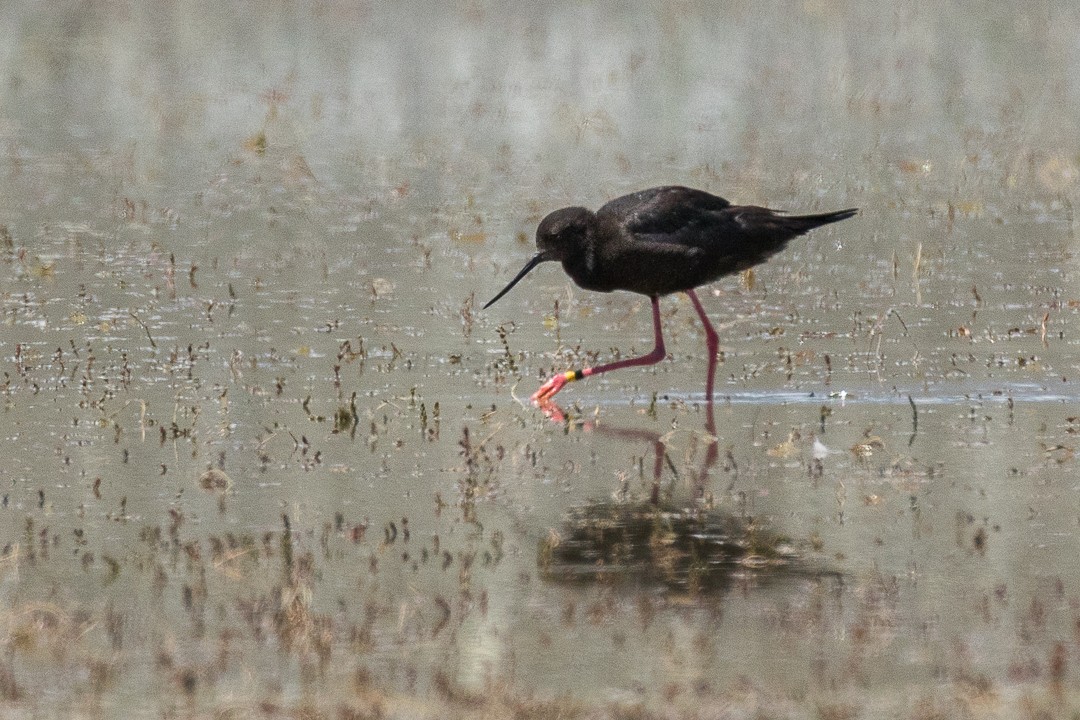Black Stilt
A species of Stilts Scientific name : Himantopus novaezelandiae Genus : Stilts
Black Stilt, A species of Stilts
Botanical name: Himantopus novaezelandiae
Genus: Stilts
Content
Description People often ask General Info
 Photo By Francesco Veronesi , used under CC-BY-SA-2.0 /Cropped and compressed from original
Photo By Francesco Veronesi , used under CC-BY-SA-2.0 /Cropped and compressed from original Description
Black stilts are a medium-sized (220 g) wader with extremely long pink legs, red eyes, distinctively black plumage, and a long slender black bill. Juveniles have a white breast, neck and head, with a black patch around the eyes, and black belly feathers that distinguish them from pied stilts. Black adult plumage appears in their first or second year. Black plumage may be an adaptation to "absorb heat better in the cold, windswept habitat of glacial riverbeds and lakeshores". Hybrids between black and pied stilts are very variable in their plumage, but usually have black breast feathers, which pied stilts never do. 
Size
40 cm
Colors
Black
White
Life Expectancy
12-15 years
Nest Placement
Ground
Feeding Habits
Black Stilt is carnivorous, feeding primarily on insect larvae, fish, as well as various molluscs, crustaceans, and worms. It employs wading and probing techniques in shallow waters to hunt, showcasing unique dietary preferences characteristic of its species.
Habitat
Black Stilt primarily inhabit freshwater ecosystems, including wetlands, braided riverbeds, and the surrounding areas. These birds are found in regions characterized by dynamic water systems, such as lake shores, shallow ponds, and swampy territories, particularly within the Mackenzie Basin. Their breeding habitats are preferably located beside stable streams or flood-prone river channels, as well as by vegetated ponds and swamps. During the non-breeding season, black Stilt may be observed in a variety of aquatic environments, such as river deltas, lake edges, and occasionally coastal lagoons and estuaries.
Dite type
Aquatic invertebrate eater
People often ask
General Info
Feeding Habits
Bird food type
Distribution Area
Although black stilts currently breed only in braided river systems in the South Island, subfossil bones show that prior to human arrival they were found in habitats as diverse as narrow bush streams in Hawkes Bay, and a wetland lake surrounded by forest in North Canterbury. In the nineteenth century they bred on riverbeds and in wetlands of the central and eastern North Island and most of the South Island except Fiordland. As late as the 1940s they were still common in South Canterbury and Central Otago, and nesting occurred in Central Otago as late as 1964. Throughout their range they have been almost entirely replaced by pied stilts, which colonised New Zealand after human settlement and now number approximately 30,000. Currently black stilts breed only in the upper Waitaki River system in the Mackenzie Basin. Most black stilts will also overwinter in the Mackenzie Basin, but about 10% of the population, especially hybrids and those paired with pied stilts, migrate to North Island harbours such as Kawhia and Kaipara in January for the winter. 
Species Status
Despite 20 years of intensive protection, the black stilt remains one of the rarest species of wading bird, and one of the most endangered birds in the world. The population may have numbered 500–1000 birds in the 1940s, but began to rapidly decline in the 1950s, and just 68 adults were counted in 1962. Intensive management began in 1981, when numbers had declined to just 23 adult birds. By 1984, there were 32 adults in the wild, rising to 52 by 1992 (with another 32 in captivity). The current wild population is estimated at 169 wild adult birds (as of May 2020), along with a captive population maintained for breeding and subsequent wild release. Annual release in the wild of these captive-bred birds, combined with predator control, have probably prevented black stilt from becoming extinct. In August 2019, 130 juvenile birds were released by the Department of Conservation onto the Godley, Cass, and Tasman rivers. 
Scientific Classification
Phylum
Chordates Class
Birds Order
Shorebirds Family
Stilts and avocets Genus
Stilts Species
Black Stilt